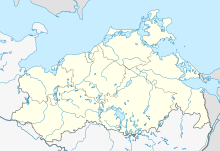Schwinzer Hellberg clay pit
Coordinates: 53 ° 36 ′ 56.8 " N , 12 ° 6 ′ 44.6" E
The Schwinzer Hellberg clay pit , which is sometimes also referred to as the Lias clay pit Dobbertin , is located in western Mecklenburg-Western Pomerania in the north of the Goldberg municipality and in the Nossentiner / Schwinzer Heide nature reserve . The site is located near the Schwinzer Ziegelei settlement on the right of the road from Dobbertin to Krakow am See , directly opposite the junction to Kleesten , east of the Dobbertiner See and north of the Goldberger See .
geology
The clay found in the pit comes from the Lower Jura (Lias). The approximately 185 million year old sediments contain fossil-bearing rock nodules (geodes) from Posidonia schist , with the help of which the geologist Eugen Geinitz correctly determined the age of the deposits as early as 1879. In addition to ammonites , melt scales and ichthyosaurs , insects were also found in the clay. With several hundred insect species from 21 insect orders, the Dobbertiner clay is one of the most prominent places where Mesozoic insects were found.
The deposit is located in the middle of a landscape shaped by the Ice Age . Glaciers from the Vistula period advanced into this area around 20,000 years ago and scraped off the layers of rock lying on the surface. Material was also recorded that lay over the tip of a nearby salt diapir , the lias tone. The material was shipped a few kilometers and deposited on the northern flank of Hellberg, where the clay pit was later built. During the transport, the clay mixed with ice-age sand.
history
In 1873 the quarrying of clay for brick production began. The brickworks was dismantled after the end of the Second World War. In the years 1952/1953 the unsuccessful attempt was made to build a new brick factory.
In 2006 a 700 meter long nature trail was set up in the area of the former clay pit. The path is lined with information boards that provide information about the geological situation and the history of clay mining and brick making.
Web links
literature
- About the fauna of the Dobbertiner Lias . Z. German. geol. Ges. Berlin. W. Hertz , 36 (1): 566-583, 1884
- The beetle remains of the Dobbertiner Lias . Archives of the Association of Friends of Natural History in Mecklenburg, 48: 71–78, 1894




